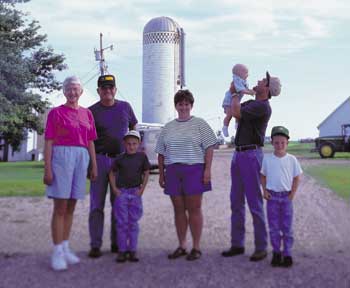
Life on the Farm
It's quiet these days on the dirt roads surrounding tiny Ralston, Iowa. In mid-July, only an occasional mini-van stirs the dust, carrying a family to nearby Glidden or to Des Moines or Omaha, both hours away.
In a couple of months it will be harvest time. The noise from machinery will mark the beginning of the growing cycle's final arc, as combines begin to take in another year's crop. Heavy rain and flooding have taken their toll down south, while farther north, hailstones have cut yields. Mother Nature has looked more kindly at west central Iowa, and will bestow another bin-buster harvest.
By October, dust will choke the roads, as truckload after truckload of corn makes its way to Ralston and a hundred towns like it throughout Iowa, Kansas and Nebraska -- the country's breadbasket. All will head to the local co-op or grain elevator to dump their loads and hurry back to the farm to fill up and do it again.
And again and again and again... thousands of times. A harvest that in years past took three months to bring in can now, with good weather, end in just a few weeks. The fields produce three times the volume of crops compared to just 10 years ago, filling the elevators to capacity, and beyond.
Union Pacific will get orders for a few trainloads of grain that will ease the storage pressure, but only a few. The farmers hold the harvest hand they have been dealt and refuse to sell, piling even more grain on that stored from last year. These quiet, hard-working feeders of the world now become the gamblers of the plains, playing a poker game called The Grain Market. Why?
"Because you always hold for a better price," says Dwayne "Pee Wee" Conner. "That's a farmer's trait. You're always optimistic. You have to be to stay in this business."
Pee Wee and his son, Matt, farm about 2,000 acres, half corn and half soybeans, a rotated mix that provides strong yields. Pee Wee and his wife, Joyce, live in a modest home near Glidden, surrounded by rustic farm buildings and Joyce's prize-worthy flower garden. Nothing fancy, just a quiet place to raise a family. Pee Wee, 60, says he's been farming all his life.
"I started right after high school in '56. I guess it was just about all I ever wanted to do," he says. "I was born on a farm, raised on a farm. My dad farmed just a few miles from here. I started just how Matt did, I furnished the labor and my dad furnished the machinery. I picked up 160 acres and helped him farm his land -- about 600 acres, which was a lot back then.
"My granddad was from this part of Iowa. He was a farmer, too. You do it because of the freedom to do things your own way. There's a lot of satisfaction in it."
In addition to crop farming, Matt also feeds hogs and farrows -- raises -- about 1,500 sows a year on his farm just a couple dirtroad miles away from Pee Wee's place. That's where they keep most of their implements, including their massive combine, a must for any large operation. Farrowing pigs is an inexpensive way for a young farmer to expand, since it takes little area to start up. But it's tough work that demands year-round attention. And Matt counts himself among the few independent farrow-to-finish guys left in the area.
"I've been raising pigs since I was 10," Matt says. "I spent a year at a trade school for carpentry, but I guess I just enjoy raising things. Whether they be pigs or crops, I like watching things grow."
